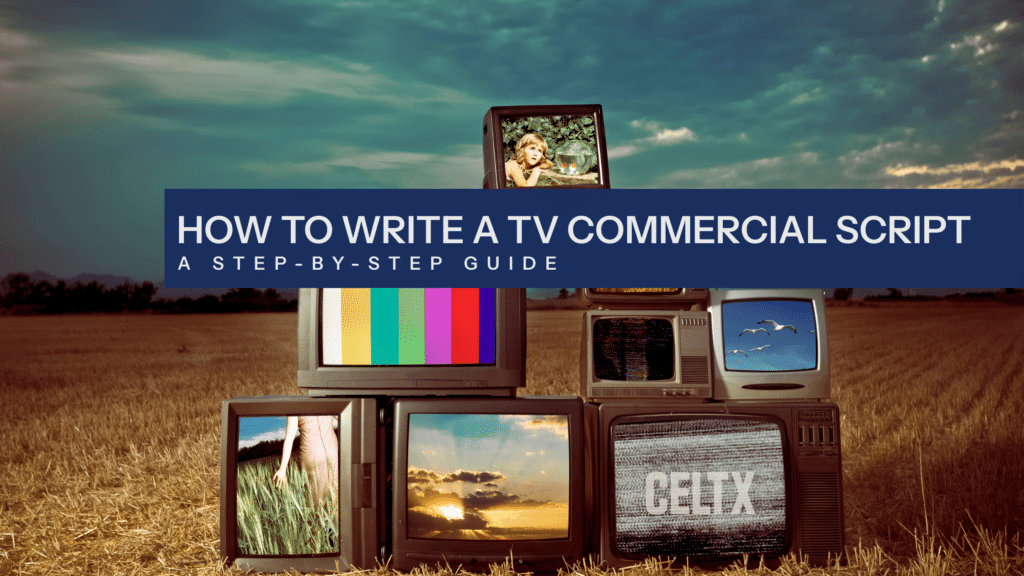
Commercials aren’t a new thing. For years, people have been using words to sell, sell, sell. From products to services, advertising can bring in big money. In the grand scheme of things, television commercials are a relatively new form of advertising, however, they have had a huge impact on our spending habits.
You’d be forgiven for thinking that TV commercial scripts are just like writing a short screenplay – well, not quite. It’s a very different ball game.
If you’re eager to write commercials, then you’re about to dive into one of the most creative, fast-paced forms of storytelling out there. You’ll need to grab people’s attention in mere seconds and influence them to act.
In today’s blog, we’ll be running through how to write a killer TV commercial script step-by-step. So, if you’re a writer looking to expand your skills, a marketing pro trying to sharpen your edge, or someone who’s just keen to learn more, you’ve come to the right place.
So, without further ado…
In This Article:
- What is a TV Commercial Script?
- Understanding the Structure of a Commercial
- Step-by-Step Guide to Writing a TV Commercial
- TV Commercial Script Example
- Formatting Your Commercial Script in Celtx
- Common Pitfalls & How to Avoid Them
- Conclusion

What Is a TV Commercial Script?
A TV commercial script is the blueprint for a commercial.
It tells everyone involved, from the director to the sound designer, to the camera operator, what’s supposed to happen and when.
Much like a screenplay, a commercial script will include dialogue, scene directions and visuals, but will also detail sound effect, music cues, and most importantly, the sales pitch!
Here’s the thing to remember: writing a TV commercial isn’t just about clever lines or pretty shots, it’s about marketing and a strong strategy. Think a mini-movie meeting business. And where does it begin? With the script. Yup, even this famous Skittles ad begun on the page.
Hungry for more? Check out some more of the world’s most famous commercials here.
Understanding the Structure of a Commercial
Okay, let’s cut to the chase, you’re not going to have a lot of time to convey your message, so it needs to be punchy.
Typically, commercials fall into one of three time frames:
- 15 seconds (blink and you’ll miss it!)
- 30 seconds (also known as the sweet spot)
- 60 seconds (the ‘luxury’ ad)
While you may have a very short space of time to fit in everything you want to say, this doesn’t mean your commercial should be straightforward. Remember, you’ve got to tell a whole story (hook, conflict, solution and payoff) within seconds.
So, just how should you structure your commercial? Let’s use the classic 30 second ad to break things down, with some help with one of Apple’s “Get a Mac” ads from the mid-2000s.
30-second commercial breakdown – Apple “Get a Mac” (2006)
The Hook (00:00-00:05 seconds)
Grab your audience’s attention!
At the start of the Apple ad, we see two guys on a white background. The one in the hoodie says he’s a Mac, the one in the suit says he’s a PC.
We’re instantly grabbed by the simple, yet quirky set up. We want to see where this will go.
The Problem (00:06-00:15 seconds)
Next, it’s time to introduce the problem and make your audience feel something.
When PC repeatedly sneezes in the Apple ad and says he has a ‘virus that’s going around’ we immediately relate to him on both human and technological levels (PCs get viruses all the time).
This section hits a pain point for the viewer without being too heavy-handed.
The Solution (00:16-00:25 seconds)
Now you hit the audience with the good stuff.
While PC continues to sneeze, Mac looks chilled out and healthy. He says one simple sentence which presents a solution: ‘Yeah PCs (get viruses) not Macs’. Yes, it’s simple alright, but it’s clean and direct, allowing Apple to position themselves as the simple, stress-free solution.
The best part? There’s not a product in sight! Only the visuals in front of us and the dialogue.
The Call to Action (CTA) (00:26-00:30 seconds)
Tell your audience what they need to do next.
With PC still looking and sounding unwell, he collapses with one last phrase ‘I think I’m gonna crash’, leaving Mac by himself. While this isn’t a traditional call to action, it drives home the point Apple are trying to make. That their hardware is healthy and easy to use.
For a 15 second or 60 second commercial, the proportions of each section will be the same as in the 30 second (you do the math!).
Step-by-Step Guide to Writing a TV Commercial
Okay, so we know the structure of a TV commercial, but let’s run through how to construct one step-by-step:
Step 1| What’s the Point?
No, seriously, what’s the goal of the commercial? Do you want people to:
- Buy something?
- Visit a website?
- Think of your brand differently?
- Laugh so hard that they remember you?
It’s crucial that you’re clear on the commercial’s main objective. If you don’t know what you’re aiming for, you’ll miss every time.
Step 2 | Know Your Audience
Like all media, commercials are never aimed at absolutely everyone. Be specific about who your audience are. Ask yourself:
- Are they parents needing solutions to make their lives easier?
- Are they Gen Z fashionistas on TikTok?
- Are they small business owners looking for reliable software?
Picture a specific person to aim your ad to. Give them a name and directly address them.
Whoever they are, make sure to match the tone, language and vibe of your commercial to the people you want to reach.
Step 3 | Craft a Killer Concept
Okay, now we’ve reached the fun part. Once you’ve determined your goal and your audience, you need to come up with a big idea.
Essentially, your concept is the twist, the angle and the hook and how you’ll grab people’s attention and keep it. Think outside the box, like:
- What if pets could give Yelp reviews about their food?
- What if our product was a superhero?
- What if Mondays were literal monsters and we defeated them with coffee?
These ideas may sound wild, but it’s important to not limit yourself. Get weird and narrow it down to the concept that both hits your goal and speaks to your audience.
Step 4 | Write the Script
As we know, commercial scripts are very different from short films, features or TV scripts. Most commercial scripts are formatted in two columns:

TV Commercial Script Example
Here is the breakdown of the script using Celtx’s very own user-friendly commercial script template:

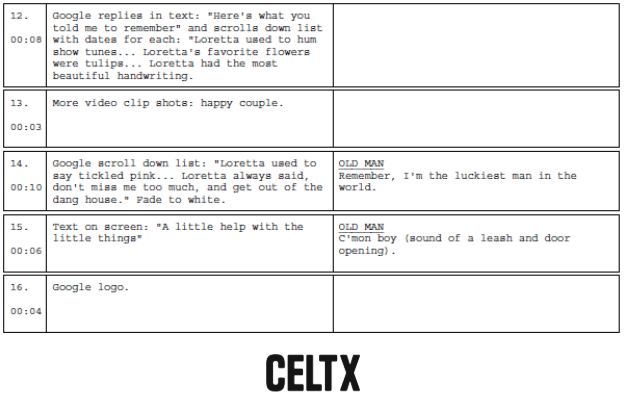
Let’s see the script in action with the finished commercial:
As you can see, the script is simple, clean and clear. You don’t need Oscar-winning drama, just a smart idea, a few relatable visuals, and a message that hits.
Celtx Top Tips
- Write how people talk. If it sounds weird out loud, rewrite it.
- Use contractions. Instead of “You are going to love it”, use “You’re going to love it”; it flows off the tongue easier.
- Keep it short and cut the fluff.
- Make sure to time your script. Read it aloud and clock yourself. Remember, every second counts!
Formatting Your Commercial Script in Celtx
As we’ve already seen, Celtx is a great tool for scripting commercials. We take care of the formatting so you can focus on storytelling.
Let’s create an ad script:
1. Start a New AV Script
First, on your Celtx dashboard, click Create.

Next, select Multi Column AV from the four script options.
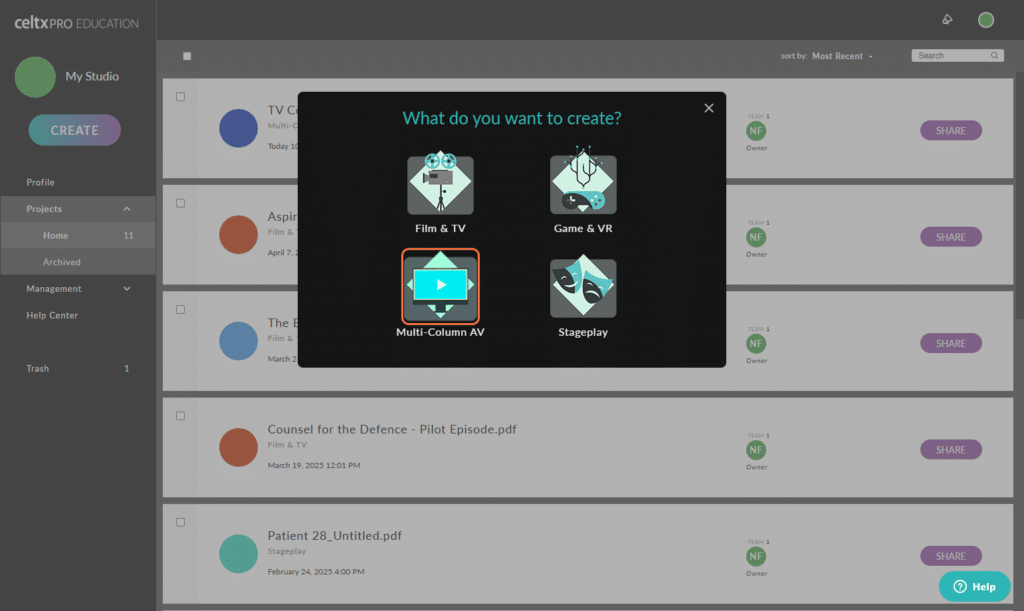
Type in a file name of your choice.
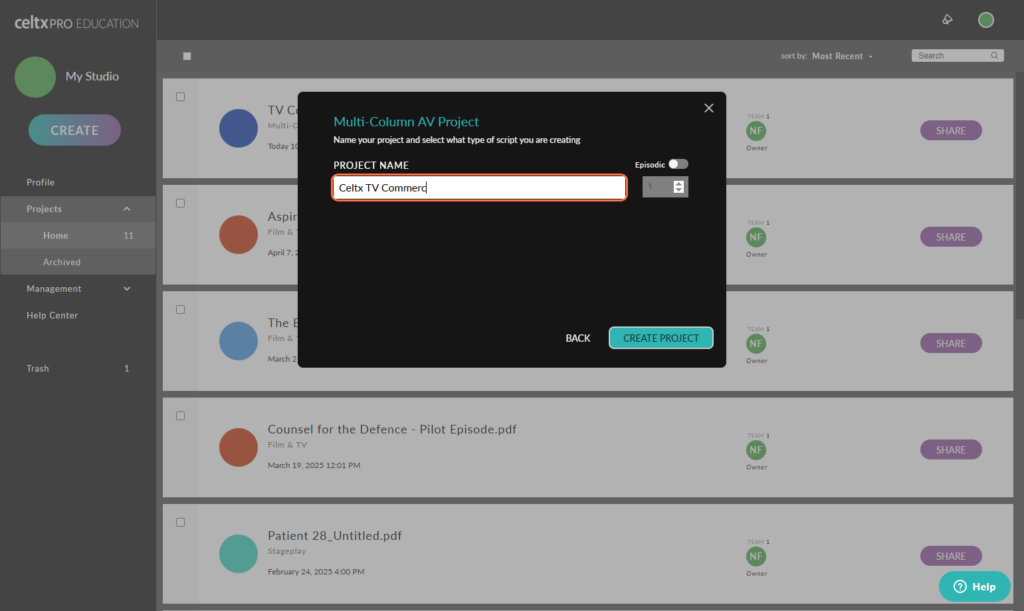
Finally, click Create Project.
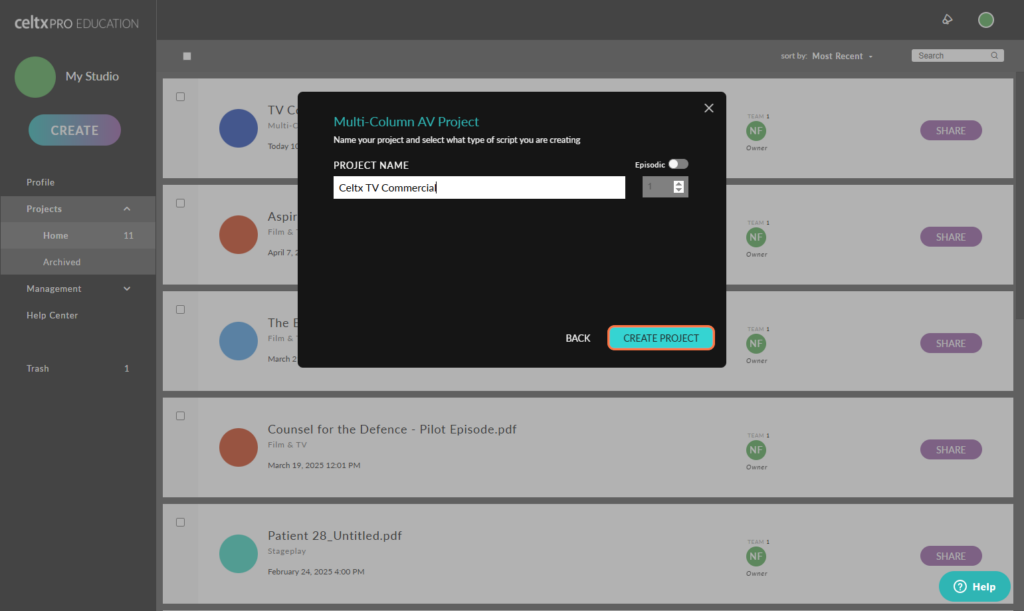
Sure enough, a new commercial script will appear with two columns: Visual and Audio, ready for your words. You can even add notes, camera directions, or transitions.
2. Add Time Markers
This is optional but can be extremely helpful. Here, I’m writing a 30-second commercial, so I want the first 5 seconds to be the hook.

To add a time marker, click on the time in the far left-hand column and type in the time frame in minutes and seconds. For this example, it’ll be 00:05.

3. Add Your Visual and Audio Elements
In the visual column, you’ll want to add what the audience will see on screen for the duration of that time marker. In the audio column, consider what they will hear alongside the visuals.
Will it be music or a voiceover, or will characters on screen be talking?
Once you’ve added both the visual and audio, it’ll look something like this:

Once you’ve completed a shot, it’s time to move onto the next one. To add a shot, all you need to do is click the + sign at the top left-hand corner of the script window.

Gradually build up each shot for each time marker and soon you’ll have a complete commercial.
4. Add Image References
Celtx even allows you to add images to your script. Or if you fancy creating a storyboard, there’s that option too.
To add an image to your commercial script, open the Images column on the right-hand side of the window by clicking the arrow.
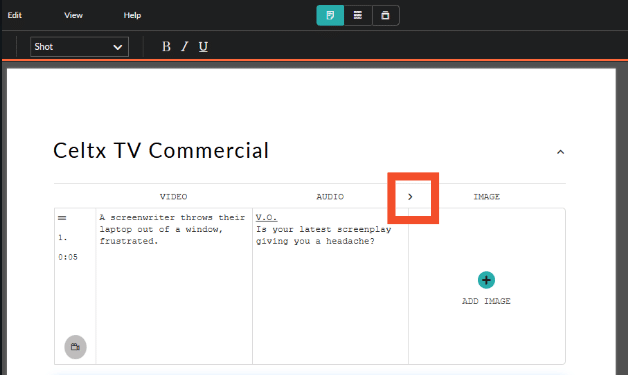
Then click Add Image.
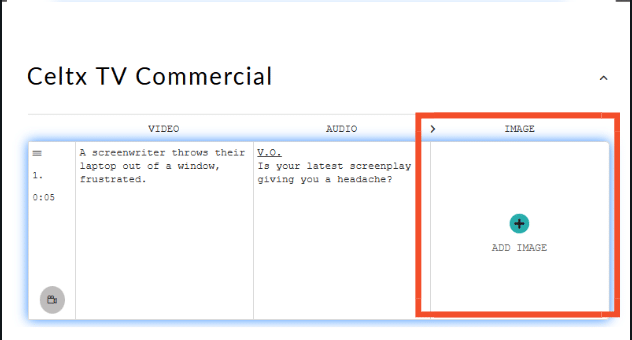
From there you can choose from your image library in Celtx or upload a brand new image from your device.
Fancy creating a storyboard to accompany your script? Well, we’ve got you covered! To access your storyboard, click on the Storyboard tab at the top of the script window.
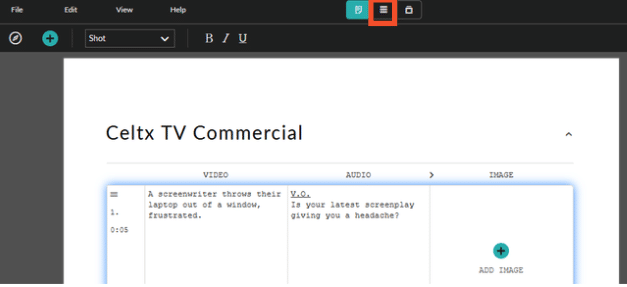
Then, your storyboard will appear, making your creating process even easier.
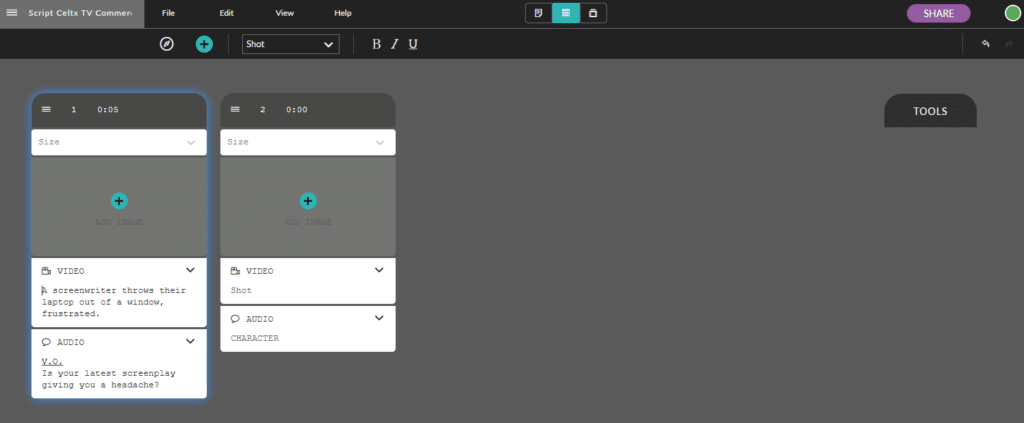
5. Share and Collaborate
Once you’re done, Celtx makes it super simple to share the script with your team, export as a PDF, or collaborate in real time. Writing doesn’t always have to be lonely!
Use Celtx’s multi-column A/V Editor to bring your commercial scripts to life.
Try it for free today!
Common Pitfalls & How to Avoid Them
Even the best writers trip up. But of course, we want to minimize that as much as possible. Here are the top four things to watch out for as you write your commercial script:
1. Don’t try to cram too much in
Remember you only have 15, 30, or 60 seconds to grab the audience’s attention and maintain it. Focus on one core message and don’t try and tell the audience everything about your brand.
Say the most important thing and say it well!
2. Don’t have a vague CTA
Make sure your call to action is specific and tangible for people to do. Instead of just saying ‘check us out’, ask your audience to visit your website, call for a free quote, or download your app. Something they can do in real time!

3. Don’t underuse your visuals
You’d be surprised, but many writers forget that TV is a visual medium, so relying too much on voiceover isn’t a good idea. Use your visuals to tell the story too.
4. Don’t forget the tone
If you’re looking to sell life insurance but adopting TikTok-style dancing to sell it, you’re probably missing the mark. It’s crucial that your commercial matches both the brand and the product.
Have the type of people you’re trying to appeal to at the forefront of your mind at all times.
Conclusion
So, there you have it. A full-on breakdown of how to write a TV commercial script that actually works.
Let’s recap what you need to write a stellar TV commercial:
- Know your goal
- Know your audience
- Nail the concept
- Keep it short, clear, and punchy
- Use visuals to tell the story
- Finish strong with a clear call to action
Don’t forget to sign up to Celtx to access our second-to-none, comprehensive commercial script writing tools and template that allow you to focus on what’s important – writing.
And that, our wonderful readers, is our call to action!
Eager to learn more? Try these articles next:
- How to Write a TV Show Script (A True Beginner’s Guide)
- How to Become a Producer in Film and TV
- How to Become a TV Writer [Guide + Salaries]
